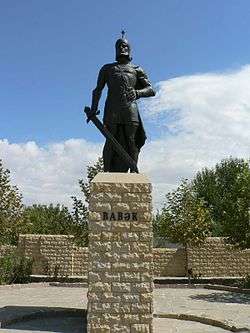Khurramites
The Khurramites (Persian: خرمدینان Khorram-Dīnân, meaning "those of the Joyful Religion") were an Iranian[1][2][3] religious and political movement with its roots in the movement founded by Mazdak.[3] An alternative name for the movement is the Muḥammira (Arabic: محمرة, "Red-Wearing Ones"; in Persian: سرخجامگان Sorkh-Jâmagân), a reference to their symbolic red dress.

Origins and history
The sect was founded in the 8th century CE by the Persian cleric Sunpadh and was a revitalization of an earlier sect that had mixed Shī‘a Islam and Zoroastrianism; however, its true claim to fame was its adoption by Bābak Khorramdin as a basis for rebelling against the Abbasid Caliphate.
The sect grew out of a response to the execution of Abu Muslim by the Abbasids, and denied that he had died, rather claiming that he would return as the messiah. This message was further confirmed by the appearance of a prophet named al-Muqanna‘ "The Veiled", who claimed that the spirit of God had existed in Muhammad, ‘Alī and Abu Muslim.
Under the leadership of Bābak, the Khurammites proclaimed the breakup and redistribution of all the great estates and the end to despotic foreign rule. Taking advantage of the turmoil created by the Abbasid civil war, in 816 they began making attacks on Muslim forces in Iran and Iraq. The Abbasid suppression of the rebellion led to the flight of many thousand Khurramites to Byzantium, where they were welcomed by emperor Theophilos and enrolled in the Byzantine army under their Iranian leader, Theophobos.
Beliefs
| Part of a series on |
| Zoroastrianism |
|---|
Atar (fire), a primary symbol of Zoroastrianism |
|
Primary topics |
|
Divine entities
|
|
Scripture and worship |
|
Accounts and legends |
|
Related topics |
|
|
Al-Maqdisi mentions several facts. He observes that "the basis of their doctrine is belief in light and darkness"; more specifically, "the principle of the universe is Light, of which a part has been effaced and has turned into Darkness". They "avoid carefully the shedding of blood, except when they raise the banner of revolt". They are "extremely concerned with cleanliness and purification, and with approaching people with kindness and beneficence". Some of them "believed in free sex, provided that the women agreed to it, and also in the freedom of enjoying all pleasures and of satisfying one's inclinations so long as this does not entail any harm to others".[4] (their name is most frequently derived from the Persian word khurram "happy, cheerful"[5]). Regarding the variety of faiths, they believe that "the prophets, despite the difference of their laws and their religions, do not constitute but a single spirit".[4] Naubakhti states that they also believe in reincarnation (metempsychosis) as the only existing kind of afterlife and retribution and in the cancellation of all religious prescriptions and obligations. They highly revere Abu Muslim and their imams. In their rituals, which are rather simple, they "seek the greatest sacramental effect from wine and drinks". As a whole, they were estimated by Al-Maqdisi as "Mazdaeans... who cover themselves under the guise of Islam".
Legacy
According to Turkish scholar Abdülbaki Gölpınarlı the Qizilbash ("Red-Heads") of the 16th century – a religious and political movement in Azerbaijan that helped to establish the Safavid dynasty – were "spiritual descendants of the Khurramites".[6]
See also
- Islamic conquest of Persia
- Kaysanites Shia
- Qarmatians
- List of extinct Shia sects
- Bahram Chobin
Notes
- Arthur Goldschmidt, Lawrence Davidson, “A concise history of the Middle East”, Westview Press; Eighth Edition (July 21, 2005). Pg 81: “..a Persian named Babak whose rebellion lasted twenty years. These uprisings were inspired by Persia’s pre-Islamic religions, such as Zoroastrianism (the faith of the Sassanid ruler) and a peasant movement called Mazdakism”
- Whittow (1996), The Making of Orthodox Byzantium, 600–1025. New studies in medieval history, London: Macmillan, pp. 195, 203 & 215 Azerbaijan was the scene of frequent anti-caliphal and anti-Arab revolts during the eighth and ninth centuries, and Byzantine sources talk of Persian warriors seeking refuge in the 830s from the Caliph's armies by taking service under the Byzantine emperor Theophilos. [...] Azerbaijan had a Persian population and was a traditional centre of the Zoroastrian religion. [...] The Khurramites were a [...] Persian sect, influenced by Shiite doctrines, but with their roots in a pre-Islamic Persian religious movement.
- W. Madelung, "Khurrammiya" in Encyclopaedia of Islam. Edited by: P. Bearman , Th. Bianquis , C.E. Bosworth , E. van Donzel and W.P. Heinrichs. Brill, 2009. Brill Online. Excerpt: "Khurrammiya or Khurramdiniyya refers in the Islamic sources to the religious movement founded by Mazdak in the late 5th century A.D. and to various anti-Arab sects which developed out of it under the impact of certain extremist Shi'i doctorines."
- Yarshater, Ehsan. 1983. The Cambridge history of Iran, volume 2. P.1008
- Yarshater, Ehsan. The Cambridge history of Iran, volume 2. P.1005
- Roger M. Savory (ref. Abdülbaki Gölpinarli), Encyclopaedia of Islam, "Kizil-Bash", Online Edition 2005
External links
- Evangelos Venetis "ḴORRAMIS IN BYZANTIUM". Encyclopaedia Iranica Online. July 20, 2005. Retrieved January 6, 2013.
- Encyclopaedia Iranica, ḴORRAMIS
- Encyclopaedia Iranica, BĀBAK ḴORRAMI